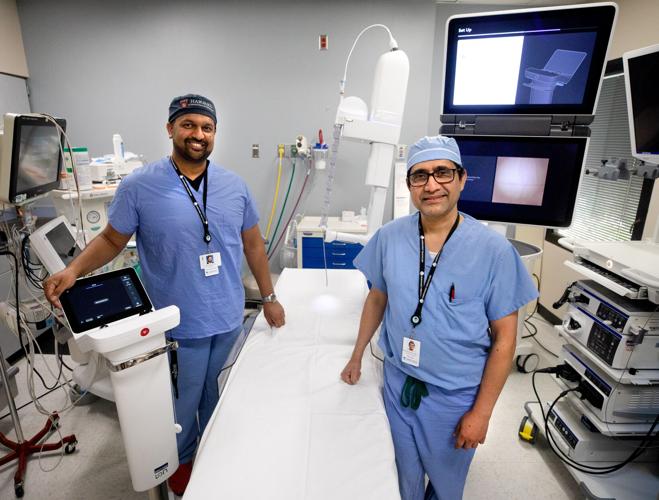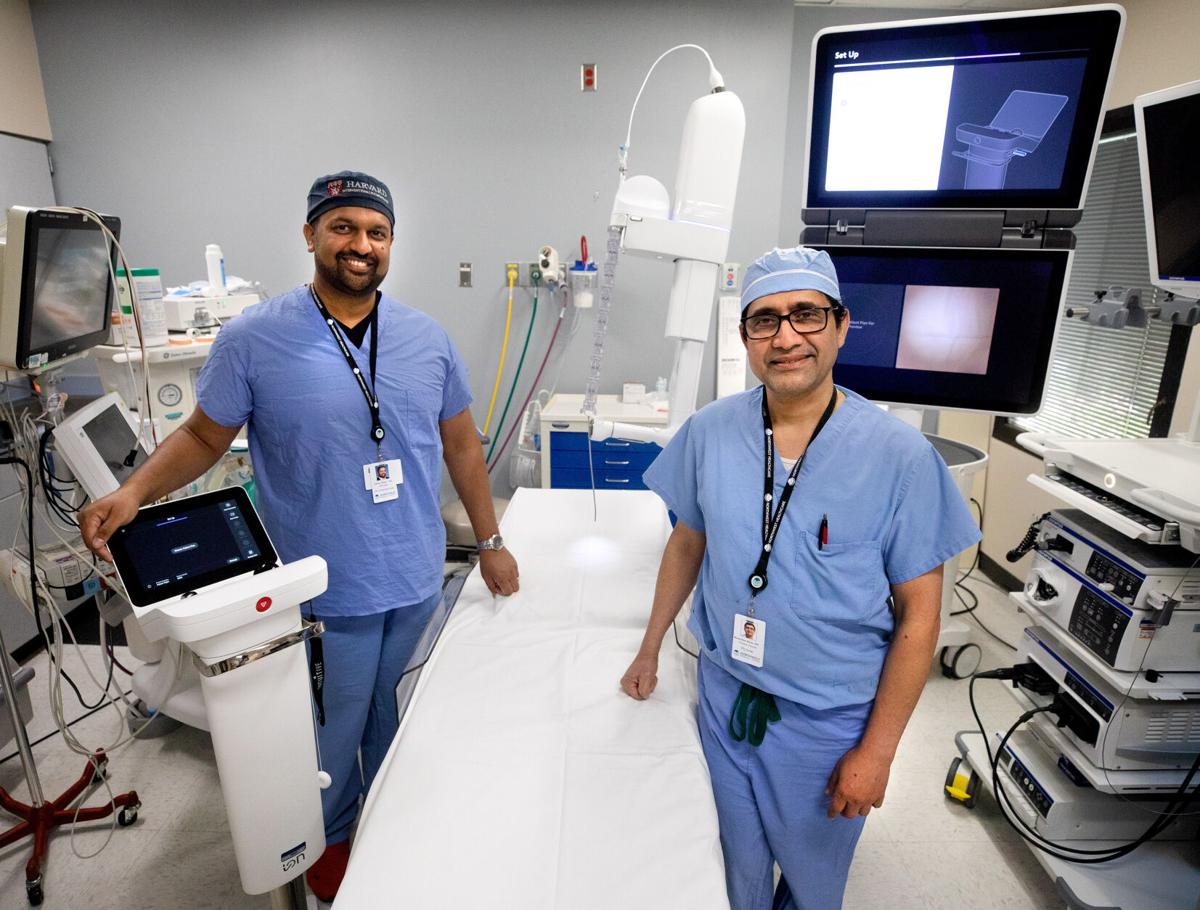Two Tucson hospitals have added robotic-assisted bronchoscopy technology, allowing doctors to diagnose lung cancer and determine the extent of its spread in a single procedure.
The Ion robotic-assisted bronchoscopy platform launched at Banner-University Medical Center last week and at Northwest Medical Center Earlier this year. The device allows doctors to perform minimally invasive lung biopsies that can reach a diagnosis, pinpoint the stage of a tumor and mark its size and location prior to surgery. Tucson Medical Center has been using the Ion system since last spring.
Without the technology, lung cancer diagnosis and staging — determining how much a tumor has grown and spread — typically requires patients to undergo separate procedures, lengthening the time to receive a complete diagnosis and possibly delaying the start of care. Best practice is for treatment to begin within 30 days of suspicion of lung cancer.
Lung cancer is the third most common cancer in the United States, leading to nearly 140,000 deaths in 2019, according to the Centers for Disease Control and Prevention. The same year, 221,097 new cases were reported. From 2015 to 2019, nearly half of all cases were diagnosed at a later stage, meaning the cancer had spread from the lungs to distant parts of the body.
The American Lung Association reported that in 2022, Arizona had an above-average rate of new cases, an average rate of early diagnosis, and was among the lowest in the nation for early screening and surgical treatment of lung cancer. The report also showed Arizona topped the nation for lack of treatment, with 32% of cases receiving no treatment.
Physicians at Banner and Northwest say the ability to diagnose, stage and start treatment in days instead of weeks is a game-changer in improving patient outcomes since lung cancer only takes about four weeks to progress from one stage to another.
Banner
Lung cancer is often diagnosed after a doctor finds a small spot, shadow or mass — called a lung or pulmonary nodule — on a patient’s x-ray. About 95% of these nodules are not cancerous, but on an x-ray, they look identical to a malignant nodule, meaning that higher-risk patients need additional testing — typically a biopsy — to reach a diagnosis if a doctor finds a nodule in any of the 18 segments of either lung.
With very small nodules, biopsy wasn’t always possible, but the Ion technology allows doctors to visualize, access and biopsy even the smallest spots.
“With the Ion, we can get to a lot of things, small little things in peripheral airways,” said Dr. Stephanie Worrell, a thoracic surgical oncologist at Banner. “We didn’t have a way to biopsy them safely before so we’d have to tell patients ‘we’ll wait and see if it grows.’”
Banner, at 1625 N. Campbell Ave., has the only National Cancer Institute-designated cancer center in the state, which allows it to conduct clinical trials on patients with early and advanced lung cancer.
Banner is also home to one of two surgeons in Southern Arizona who specialize in thoracic surgery, which includes the lungs, esophagus, trachea, diaphragm, chest wall and mediastinum, or area between the lungs. Both doctors use robotic assistance when applicable since the technology allows for better visualization and increased precision. The second works at Northwest Medical Center.
Worrell arrived at Banner in January 2022 and said that before she came, robotic thoracic surgeries were performed on occasion. Now they’re performed regularly, with the team completing more than 100 robotic cases since Worrell’s arrival. The team, which includes dedicated thoracic medical and radiation oncologists, is also growing. By the fall, they’ll have four interventional pulmonologists and two thoracic surgical oncologists.
With the arrival of the Ion, Worrell and her team are able to perform single-anesthesia care, meaning they can diagnose and treat a patient with robotic surgery in the same anesthetic event. They use the Ion to perform the biopsy, send the results to pathology for diagnosis, and then proceed with the removal, if necessary, using a different robotic device.

Use of robotics allows doctors to make small incisions, resulting in fewer complications and shorter hospital stays than with traditional procedures, Worrell said.
“Surgeons love it. They (patients) go to sleep, we do the biopsy and if it’s cancer, I can just do my procedure right there,” Worrell said. “It gets you cared for much faster.”
Worrell said she’s seen the care available to lung cancer patients in Southern Arizona improve dramatically in the 16 months she’s lived here, and she’s hopeful for a continued upward trajectory.
“When I came here, I feel like there wasn’t a lot going on in Tucson in terms of robotics,” she said. “Now, it’s pretty awesome. We have the robotic Ion and robotic surgery that I’m doing and other people as well.”
Northwest
At Northwest Medical Center, 6200 N. La Cholla Blvd., the Ion system has been in use since late January. Dr. Abhinav Mittal, an interventional pulmonologist and critical care specialist, said it’s been widely used already, with 44 bronchoscopies performed in less than four months.
Mittal works in the center’s pulmonary program, which Northwest has been bolstering for several years.
Brian Sinotte, Northwest’s chief executive officer, said that when he came on a few years ago, there was a relative shortage of pulmonary specialists and access to care in Southern Arizona, despite the higher rates of lung cancer in the state.
“We decided, we’ve got to address this,” Sinotte said. “We want to make a real impact for not only Tucson, but also Southern Arizona.”
Many lung cancer cases are diagnosed in later stages, and Arizona has some of the lowest rates in the nation of lung cancer screening, Mittal said, adding he’s hopeful this new technology will help move the needle. He said the five-year prognosis on cases diagnosed at later stages is “pretty bad.”
The Ion platform will also reduce the risk of complications brought on by the need for a separate biopsy. Traditional lung biopsies have a complication rate of up to 40%, and without robotic assistance, a patient will still need to undergo a separate bronchoscopy to determine the cancer’s stage.
Mittal said the Ion procedure only takes about 45 minutes, start to finish, with the time the patient is under anesthesia actually much shorter.
Despite its short duration, Mittal said the procedure is quite thorough and complex since he uses both x-rays and ultrasounds to confirm staging in lymph nodes throughout the thoracic area.
Results typically take less than a week to come back at Northwest and from there, Mittal consults with a panel of experts to help determine the best course of treatment and next steps.
In five of the 44 cases diagnosed and staged by the Ion platform, treatment has included surgery performed by Dr. Rammohan Marla, Northwest’s thoracic surgeon.
“The advantage of having Dr. Mittal is we have accurate staging and diagnosis. (I’m) able to see the patient within a week and then we get them into surgery within two weeks, which is the standard of care,” Marla said. “They should all be starting treatment within 30 days of seeing something abnormal. That’s what we’re doing at Northwest.”
Marla said accurate staging of lung cancer could prove challenging in the past, with tumors initially believed to be stage 1 or 2, sometimes turning out to be stage 3 when visualized during surgery. Mittal said correct staging is especially important, as the disease is curable in stage 1 and 2 but often is not in stage 3 or 4.
With the Ion robot, 100% of the cases referred for thoracic surgery by Mittal have been correctly staged, Marla said.
“Universally, we’ve all become much more in tune with matters of the brain and heart, but when it comes to lungs, time is also an equally important as a factor,” Sinotte said.
Every four weeks that lung cancer goes untreated it progresses to the next stage, Mittal said, which can be the difference between a cure and resorting to palliative care to keep a patient comfortable.
“One of the main reasons I wanted to come work at Northwest is that you don’t want to have to have interventional pulmonology without a strong thoracic surgery. Some of the advanced things I do, I can’t without having the really strong backup of a reliable thoracic surgeon,” Mittal said. “There is a difference between a cardiac guy who does hearts most of the time and lungs on the weekends and someone who purely does thoracic cases. There’s really good data that suggests the outcomes for patients … are statistically better with a thoracic surgeon.”
Ion-assisted bronchoscopies are covered by most insurance companies, and consolidating the number of procedures needed to stage and diagnose provides a cost saving to both insurance providers and patients, Marla said.
Of the 44 cases diagnosed and staged with the Ion robot, 14 were stage 1 or 2 and have already been referred to Marla for a cure, Mittal said.
“(At Northwest), you’re getting the right care. It’s not about doing everything, it’s about doing the right thing,” Mittal said. “When you send a patient to our team, they get the right care the first time. We do the fewest amount of procedures for best outcome of patients.”
Get your morning recap of today's local news and read the full stories here: http://tucne.ws/morning






